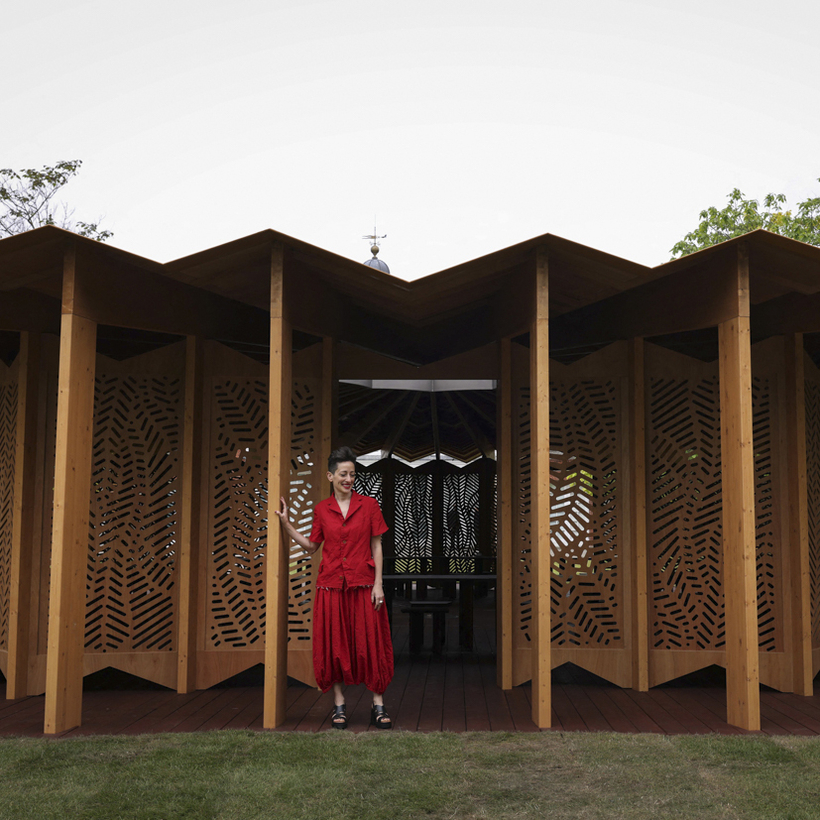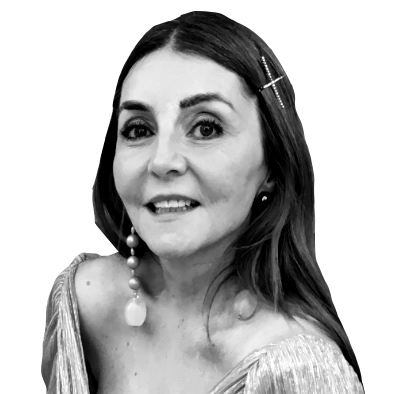The bucolic setting of London’s Serpentine Gallery—romantically nestled under a rich canopy of trees near the lake in Kensington Gardens, where ducks and swans float among the paddleboats—can be deceiving. It is considered one of the capital’s punchiest avant-garde arts institutions, and this year, it is showcasing the work of Lina Ghotmeh, a Paris-based Lebanese architect.
Every year since 2000—with the exception of 2021, due to Covid—the Serpentine has invited a globally renowned architect who has not previously worked in the U.K. to design a temporary structure—a pavilion, or a folly—to stand on its south lawn from June to October, a communal space where visitors could hang out and have a coffee with friends. In recent years, it has also become a venue for the gallery’s Park Night events—performances and talks related to art, music, literature, and dance—as well as its annual humdinger of a party.
Now it’s Ghotmeh’s turn. She follows formidable talent. Zaha Hadid originally developed the idea (along with the gallery’s former director Julia Peyton-Jones) for an architecture pavilion, and she designed the first one. Others to tackle the project have included Daniel Libeskind, Oscar Niemeyer, Frank Gehry, and Jean Nouvel.

I met with her one afternoon at the gallery and found that her demeanor is particular to so many successful architects—timid and a little startled by the attention—and so is her punky look. She was wearing head-to-toe black (an Issey Miyake top, voluminous harem pants, and flat chunky boots), with a streak of bright-red lipstick as her only pop of color. Her head is shaved on both sides, and an abundant Elvis-style pompadour sits atop it. I laughed to myself: as a child who also grew up in Beirut, I spent hours loitering on a stool at salons doing my homework and listening to the gossipy chatter around me while my mother and aunt had endless, fancy blowouts.
Ghotmeh was selected by a committee that included, among others, the Serpentine’s director, Hans-Ulrich Obrist; Bettina Korek, the gallery’s C.E.O. since March 2020; and the architect David Adjaye, who first suggested commissioning Ghotmeh.
“They asked me for a meeting,” she says, speaking with an accent that I know well. She says she had no idea what it was for. I asked Obrist what drew the committee to Ghotmeh. “David always says Lina brings so many disciplines together,” he tells me. “She’s an architect, but also an artist, lecturer, lover of theater, performance, and sculpture.”

Ghotmeh was given one month to come up with a design. “I thought I would get two or three years,” she says with a laugh. She began by researching park follies. “I knew my design had to express our times and be meaningful,” she says. “I showed them my idea, and they loved it.”
The pleated, timber-colored roof of her pavilion was coming to life on the lawn outside. Partially visible through a window, it reminded me of an oversize beach parasol or a spiny Amazonian leaf, shielding the open circular space beneath it.
Laser-cut, Arabian-style mosaic panels diffuse sunlight through diaphanous prisms throughout the space, reflecting the more spiritual and lyrical bent of the younger architects recently chosen for the assignment, such as the Chilean Smiljan Radić (2014), the Mexican Frida Escobedo (2018), and Theaster Gates, who designed the pavilion in 2022.
Ghotmeh drew inspiration from the sympósia (forums) of ancient Greece, where elders would gather to talk and eat; the circular Druid encampment of Stonehenge; and the toga huts of the Dogon people, in Mali. It feels particularly apposite when she describes her genre of architecture as “archaeology of the future.”
Nothing speaks to that more than her Lebanese roots. Ghotmeh, one of four children, grew up during the Lebanese Civil War eating homemade food prepared with local ingredients while seated at beautiful, lively meals. She particularly remembers those conversations, which is why the theme for her pavilion is “À table,” the French call to arms. “The table was very important,” Ghotmeh says. “It was when our parents would ask us about our day, our studies, where we had discussions about art and literature.”
But her memories stretch beyond that idyll. It’s a Lebanese joke that as the bombs rained down, the parties never stopped. I remember sleeping in corridors dodging sniper fire, watching the fireworks of war in the distance from our balcony without fully understanding what they meant. But we’d always go to the beach the next day, and to restaurants in the evenings.
“My siblings and I had to run and hide in the basement because we lived on the seventh floor of an apartment building,” she says. “As a kid you don’t really realize the world you are living in is not normal.”
She started drawing to pass the time. Her mother had studied architecture and taught graphic design, while her father worked in construction; art and architecture were always intrinsic parts of her family’s dialogue. “The arts can bring a sense of peace,” she says. “Building is a way to heal.”
It’s a Lebanese joke that as the bombs rained down, the parties never stopped.
When her parents built a house in the mountains above Beirut, she became curious about the process behind it. After graduating from the French Lycée, she still thought she should become a doctor or an archaeologist and first studied biology at the American University of Beirut. But eventually, lured by architecture’s infinite possibilities, she switched degrees.
She graduated from the A.U.B., but because the Lebanese degree was not yet recognized abroad by international firms, she moved to Paris, where she simultaneously worked and studied at the École Spéciale d’Architecture. (She has since successfully campaigned for the A.U.B.’s architecture degree to be internationally accepted, so anyone graduating from there can now work abroad without passing another set of exams, as she did.)
Her first job in her hometown involved collaborating on a project for a new building in Beirut with the Ateliers Jean Nouvel and Foster & Partners, in London. She temporarily moved there. “I went to the Tate. I discovered Damien Hirst, Olafur Eliasson, and Antony Gormley—installations, immersive art, but also cutting-edge young artists.” She spent her weekends attending theater and dance performances at the Barbican and Sadler’s Wells, fascinated by choreography and stage design.
She returned to Paris and founded her own practice in 2005, quickly gaining a reputation for her respect for nature and the place it must hold in design. She has won several competitions (including one to design the Estonian National Museum) as well as multiple awards all over the world. Most recently, she worked with Hermès, constructing their saddlery and leather workshops in Louviers.
In 2020, she traveled home to Beirut to visit her project Stone Garden, a womb-like communal-living space that was all but complete when the port explosion decimated much of the city center. “I had a bad feeling before I went,” she says. “I was very close to the site when it happened. It was apocalyptic, one of those crazy instances where you lose sense of time. It felt like the sky was littering glass—it was such a strange moment. It embodied a lot of the memories Beirut has lived through over time.” Stone Garden’s windows were shattered, but the building was otherwise intact.

The annual Serpentine Summer Party, held on the grounds in and around the pavilion, has always been one of London’s most anticipated events, and Ghotmeh is full of plans for the night. “The party is going to be a beautiful moment,” she says. The artist and composer Tarek Atoui has created a soundscape, and Ghotmeh is painting a large-scale canvas.
She is collaborating with French pâtisserie Ladurée to create special macarons for the party, as well as designing the boxes they will be presented in. “You know, I discovered that macarons were originally Middle Eastern,” she says. “There was a lot of commerce going on in the Levantine region, so thanks to all that almond paste they created, we now have the exquisite Ladurée.”
I can’t help thinking that Zaha Hadid, whom Ghotmeh never met, would have been so impressed by this young and ambitious architect. Not to mention that, coincidentally, they were both educated at the same university in Beirut. “I wish I’d met her,” she says as she stands up to greet a colleague. “She was like a queen to me.”
Vassi Chamberlain is a London-based Writer at Large at AIR MAIL

